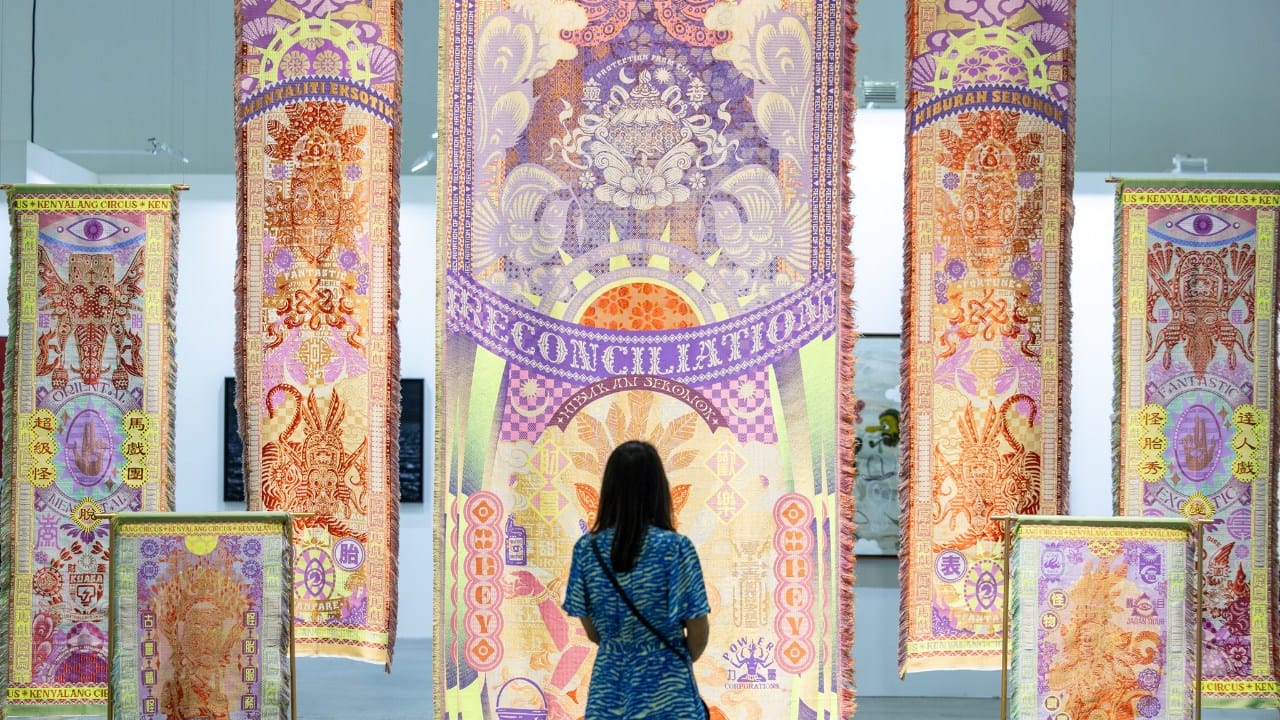Intrigued by a deep-seated urge to unravel his identity and a place in the world, rising Malaysian contemporary artist Marcos Kueh revolves his creative practice around contemporary legends onto textiles with influences from the ancestral traditions of Borneo—where epics and anecdotes were documented on fabrics long before the introduction of ciphers from the West.
Taking us back to his early stages of artistic exploration, Kueh expresses his initial interest toward textile design. “My interest in textiles emerged approximately five years ago when I was still a graphic design student. Even then, my fascination with local culture studies had already taken root,” reflects Kueh, who currently resides in The Hague. “I often wondered why my knowledge was so extensive about designers from abroad while being oblivious to designers and design movements here in Malaysia.” In a discussion with one of his professors, Kueh was asked about the designer he aspired to become. Mentioning a notable figure from New York, the professor indicated that he couldn’t attain that status because the designer’s work was closely associated with New York. “This conversation triggered a crisis of identity, prompting me to delve into understanding and illustrating my local culture. This exploration is a crucial part of my journey, as I grapple with the challenge of connecting with my lineage, especially being born in Sarawak,” Kueh expresses.

In 2022, Kueh clinched the Ron Mandos Young Blood prize, recognising his emergence as an artist. From then on, his artistic contributions have found a global stage, with several exhibitions in Amsterdam, Wassenaar and Osaka. Presently, Kueh actively investigates the presence of colonial narratives in our modern-day lives, striving to craft new myths that redefine the underlying principle of an independent nation. When asked about his approach in exploring these themes, Kueh says: “I first came across the term ‘decolonisation’ during a discussion at a museum exhibition in The Netherlands, and the experience proved overwhelming as I was confronted with its significance. This encounter became the catalyst for a school assignment where I had to dig deeper into the topic and dabbling my emotions surrounding it. The intensity of my emotions naturally guided me towards working on this subject, as I sought to grasp the complex feelings associated with it,” Kueh explains. “As an artist, I am not only navigating my personal journey but also sharing it with others. This quiet and subjective nature of decolonisation makes it a strenuous yet essential topic to experiment with.”
Just recently, Kueh sold his textile pieces at the second edition of ART SG, the leading international contemporary art fair in Southeast Asia. The highlight of Kueh’s collection, titled Woven Billboards: Nenek Moyang from his Kenyalang Circus 2023 series, comprises a 8m-long woven ‘billboard’, a pair of medium-long woven ‘banners’, and a duo of small woven ‘postcards’. Composed with industrial weaving machines, these fluorescent textile works depict Kueh’s meaning-laden questions on his Chinese-Malaysian persona hailing from Borneo. Through this imagery, Kueh satirises the distortion and misunderstanding of the diverse cultures of Borneo by both Westerners and Peninsula Malaysians. Kueh’s artwork was featured as one of the five spotlights in the PLATFORM sector of ART SG, and his gallery representative The Back Room was also among the 39 newly introduced galleries participating in ART SG for the first time.

Translated as ‘Hornbill Circus’ from Sarawakian Malay, Kenyalang Circus addresses the authenticity within a neoliberal culture of icons, adopting a mordant perspective on the commercialisation of Borneo and Sarawak as ‘Malaysia’s exotic unknown’. Kueh personally invested in this project by venturing into the faultline of heritage, as well as the tension between an inherited past and internalised foreignisation. Focusing on the concept of home, this series prompts contemplation on the ‘journey back home’ framing the work. It suggests that the very notion of home is elusive, and the pure conception of culture becomes akin to the folktales Kueh draws inspiration from—mythical.
As a young artist, navigating the art scene can be daunting. “I’ve certainly encountered my fair share of hurdles,” Kueh says. “It’s often underestimated how challenging it is to translate one’s vision into reality. Having a vision is one thing, but figuring out the practical steps to manage and achieve that vision is an entirely different aspect. I’ve also learnt a crucial lesson within my industry—it takes time to truly embrace the title of an artist. Fundraising is also a universal challenge for artists. Just as a painter needs colours to create, financial resources are essential for those in performing arts. I’m still in the process of figuring things out, continuously carving my own path within the artistic landscape.

“Looking ahead, predicting the trajectory of contemporary art on a global scale is beyond my scope, so I’ll focus on my specific aspirations,” Kueh continues. “Particularly in the Southeast Asian region and more specifically within my own field, I hope to witness a surge in artworks that encourage people to engage critically with pertinent issues.” Despite the abundance of creative output, there seems to be a hesitancy to formulate strong points, a fact not lost on Kueh. “I attribute this to a lack of encouragement or space for expression during one’s formative years,” he opines. “Breaking free from this pattern requires a learning curve, and I aim to contribute to this cultural shift by supporting such endeavours.”




